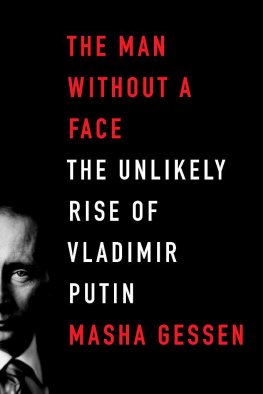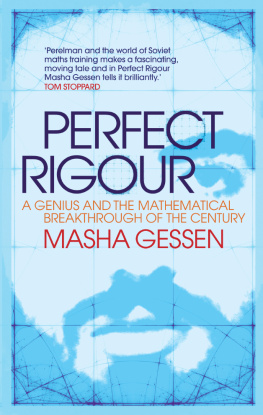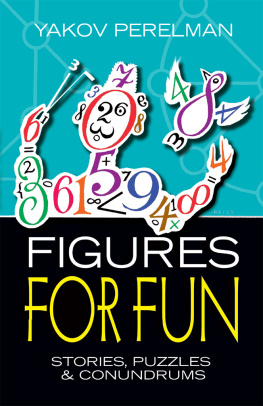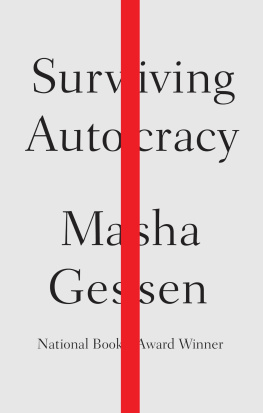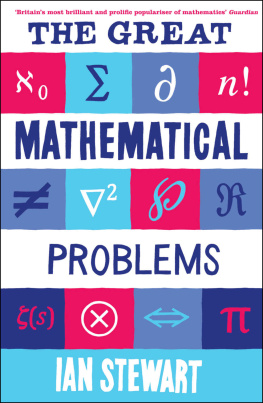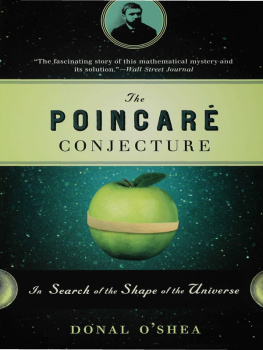Perfect Rigor
A Genius and the Mathematical Breakthrough of the Century
Masha Gessen
HOUGHTON MIFFLIN HARCOURT BOSTON / NEW YORK 2009
Copyright 2009 by Masha Gessen
ALL RIGHTS RESERVED
For information about permission to reproduce selections from this book,
write to Permissions, Houghton Mifflin Harcourt Publishing Company,
215 Park Avenue South, New York, New York 10003.
www.hmhbooks.com
Library of Congress Cataloging-in-Publication Data
Gessen, Masha.
Perfect rigor : a genius and the mathematical breakthrough
of the century / Masha Gessen.
p. cm.
Includes bibliographical references and index.
ISBN 978-0-15-101406-4
1. Perelman, Grigori, 1966 2. MathematiciansRussian (Federation)
Biography. 3. Poincar conjecture. I. Title.
QA 29. P 6727 G 47 2009
510.92-dc22 [ B ] 2009014742
Book design by Brian Moore
Printed in the United States of America
DOC 10 9 8 7 6 5 4 3 2 1
Contents
Prologue: A Problem for a Million Dollars vii
1. Escape into the Imagination 1
2. How to Make a Mathematician 16
3. A Beautiful School 33
4. A Perfect Score 60
5. Rules for Adulthood 81
6. Guardian Angels 102
7. Round Trip 112
8. The Problem 131
9. The Proof Emerges 148
10. The Madness 170
11. The Million-Dollar Question 200
Acknowledgments 213
Notes 214
Index 234
Prologue
A Problem for a Million Dollars
Numbers cast a magic spell over all of us, but mathematicians are especially skilled at imbuing figures with meaning. In the year 2000, a group of the world's leading mathematicians gathered in Paris for a meeting that they believed would be momentous. They would use this occasion to take stock of their field. They would discuss the sheer beauty of mathematicsa value that would be understood and appreciated by everyone present. They would take the time to reward one another with praise and, most critical, to dream. They would together try to envision the elegance, the substance, the importance of future mathematical accomplishments.
The Millennium Meeting had been convened by the Clay Mathematics Institute, a nonprofit organization founded by Boston-area businessman Landon Clay and his wife, Lavinia, for the purposes of popularizing mathematical ideas and encouraging their professional exploration. In the two years of its existence, the institute had set up a beautiful office in a building just outside Harvard Square in Cambridge, Massachusetts, and had handed out a few research awards. Now it had an ambitious plan for the future of mathematics, "to record the problems of the twentieth century that resisted challenge most successfully and that we would most like to see resolved," as Andrew Wiles, the British number theorist who had famously conquered Fermat's Last Theorem, put it. "We don't know how they'll be solved or when: it may be five years or it may be a hundred years. But we believe that somehow by solving these problems we will open up whole new vistas of mathematical discoveries and landscapes."
As though setting up a mathematical fairy tale, the Clay Institute named seven problemsa magic number in many folk traditionsand assigned the fantastical value of one million dollars for each one's solution. The reigning kings of mathematics gave lectures summarizing the problems. Michael Francis Atiyah, one of the previous century's most influential mathematicians, began by outlining the Poincar Conjecture, formulated by Henri Poincar in 1904. The problem was a classic of mathematical topology. "It's been worked on by many famous mathematicians, and it's still unsolved," stated Atiyah. "There have been many false proofs. Many people have tried and have made mistakes. Sometimes they discovered the mistakes themselves, sometimes their friends discovered the mistakes." The audience, which no doubt contained at least a couple of people who had made mistakes while tackling the Poincar, laughed.
Atiyah suggested that the solution to the problem might come from physics. "This is a kind of cluehintby the teacher who cannot solve the problem to the student who is trying to solve it," he joked. Several members of the audience were indeed working on problems that they hoped might move mathematics closer to a victory over the Poincar. But no one thought a solution was near. True, some mathematicians conceal their preoccupations when they're working on famous problemsas Wiles had done while he was working on Fermat's Lastbut generally they stay abreast of one another's research. And though putative proofs of the Poincar Conjecture had appeared more or less annually, the last major breakthrough dated back almost twenty years, to 1982, when the American Richard Hamilton laid out a blueprint for solving the problem. He had found, however, that his own plan for the solutionwhat mathematicians call a programwas too difficult to follow, and no one else had offered a credible alternative. The Poincar Conjecture, like Clay's other Millennium Problems, might never be solved.
Solving any one of these problems would be nothing short of a heroic feat. Each had claimed decades of research time, and many a mathematician had gone to the grave having failed to solve the problem with which he or she had struggled for years. "The Clay Mathematics Institute really wants to send a clear message, which is that mathematics is mainly valuable because of these immensely difficult problems, which are like the Mount Everest or the Mount Himalaya of mathematics," said the French mathematician Alain Connes, another twentieth-century giant. "And if we reach the peak, first of all, it will be extremely difficultwe might even pay the price of our lives or something like that. But what is true is that when we reach the peak, the view from there will be fantastic."
As unlikely as it was that anyone would solve a Millennium Problem in the foreseeable future, the Clay Institute nonetheless laid out a clear plan for giving each award. The rules stipulated that the solution to the problem would have to be presented in a refereed journal, which was, of course, standard practice. After publication, a two-year waiting period would begin, allowing the world mathematics community to examine the solution and arrive at a consensus on its veracity and authorship. Then a committee would be appointed to make a final recommendation on the award. Only after it had done so would the institute hand over the million dollars. Wiles estimated that it would take at least five years to arrive at the first solutionassuming that any of the problems was actually solvedso the procedure did not seem at all cumbersome.
Just two years later, in November 2002, a Russian mathematician posted his proof of the Poincar Conjecture on the Internet. He was not the first person to claim he'd solved the Poincarhe was not even the only Russian to post a putative proof of the conjecture on the Internet that year but his proof turned out to be right.
And then things did not go according to plannot the Clay Institute's plan or any other plan that might have struck a mathematician as reasonable. Grigory Perelman, the Russian, did not publish his work in a refereed journal. He did not agree to vet or even to review the explications of his proof written by others. He refused numerous job offers from the world's best universities. He refused to accept the Fields Medal, mathematics' highest honor, which would have been awarded to him in 2006. And then he essentially withdrew from not only the world's mathematical conversation but also most of his fellow humans' conversation.
Perelman's peculiar behavior attracted the sort of attention to the Poincar Conjecture and its proof that perhaps no other story of mathematics ever had. The unprecedented magnitude of the award that apparently awaited him helped heat up interest too, as did a sudden plagiarism controversy in which a pair of Chinese mathematicians claimed they deserved the credit for proving the Poincar. The more people talked about Perelman, the more he seemed to recede from view; eventually, even people who had once known him well said that he had "disappeared," although he continued to live in the St. Petersburg apartment that had been his home for many years. He did occasionally pick up the phone therebut only to make it clear that he wanted the world to consider him gone.
Next page


